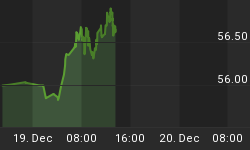I've written exhaustively about the real purpose behind the Fed's quantitative easing strategy. So one more time for those who still don't get it; the primary goal of QE is to bolster banks' balance sheets through the process of re-inflating equity and real estate prices. If investors look back at the history of QE they will be able to clearly see what happens when the Fed steps on the monetary gas; and also what occurs once it takes the foot off the pedal.
For example, even though interest rates were already near zero percent, the Fed felt it necessary to begin purchasing massive amounts of bank assets in late 2008 to get the money supply and stock prices moving in the positive direction. The Fed announced a $500 billion Mortgage Backed Security purchase program (QE1) on November 25th 2008. The central bank then followed up on March 18th 2009 with a $300 billion plan to buy long-term Treasury bonds. The total amount of $800 billion in planned QE did exactly what was intended-the U.S. markets, not so coincidentally, ended their massive decline and then started a huge secular advance in March of that same year.
Most investors now agree that massive QE can be extremely positive for asset prices. But most on Wall Street either are not aware, or refuse to acknowledge, what occurs when the central bank stops printing. Therefore, a brief history lesson seems especially prudent at this juncture.
QE1 ended on March 31st 2010. The market soon after headed south, and just over three months later the S&P 500 dropped by 12.6%. The second round of QE ($600 billion) ended on June 30th 2011. This time, stocks began to decline within days after the last bond was purchased, and after three months went by investors experienced a correction of 16.7%. In both instances, a subsequent new round of QE came to the rescue of stock prices, just about when the depth of the correction extended into the double-digit range.
Now that the Fed's QE3 is officially ending, asset prices have lost most of their momentum. The Dow Jones Industrial Average is only up just over 2 percent and most other major averages are either flat to up low single digits so far this year. This is true even though we are over half-way through 2014; and compares to the 30 percent gains experienced last year.
It is important to note that QEs 1 and 2 ended abruptly, whereas QE3 is only being slowly wound down. Therefore, the mere announcement of the Fed's taper back in January of this year did not cause a similar market reaction to that of the other QE terminations. Also, the correction from QE2's end was more profound than that of the first, because equity values become more disconnected from economic fundamentals with each round of intervention.
So investors need to ask why the stock market would be immune from the Fed getting out of the QE business this time around. The truth is that asset bubbles have become more inflated and debt levels have greatly expanded during each iteration of QE. Given this progression, the end of QE3 should bring the major averages down somewhere in the neighborhood of at least 20 percent about three months after QE3 ends in the fall.
However, before the Fed launches yet another QE rescue program like it did after QEs 1&2 failed to generate solid growth, it would have to admit that the previous five years and $3.5 trillion worth of QE have been a complete failure; and that the U.S. economy is addicted to continuous central bank credit expansion. This might not come to fruition as quickly as most on Wall Street now believe it will, and could exacerbate the percentage of the selloff.
Up until now, the perennially-weak economic growth experienced since the Great Recession ended just didn't seem to matter for the stock market. The reason for this was that interest rates were falling from a benign level that already offered little competition for equities. And, the central bank had an overwhelming desire to increase the size of its balance and launch another round of QE at the first sign of falling asset prices.
Contrast that with the situation today. The Fed has become distressed over the amount of bonds it already currently holds and wants completely out of the QE business. In addition, interest rates have ended their decline and must increase along with the rising rate of inflation and the end of Fed bond market manipulation-unless of course rates fail to rise because of a deflationary collapse of the economy.
The overwhelming consensus on Wall Street is that the economy will illustrate vastly improving economic growth during the second half of 2014, in the context of low inflation and quiescent interest rates. And the pervasive belief is also that the end of QE will not have the negative effect on stock prices that it did after the last two rounds ended. Given that this scenario is already fully priced into markets, investors would be wise to maintain a very defensive posture during the next few months.















